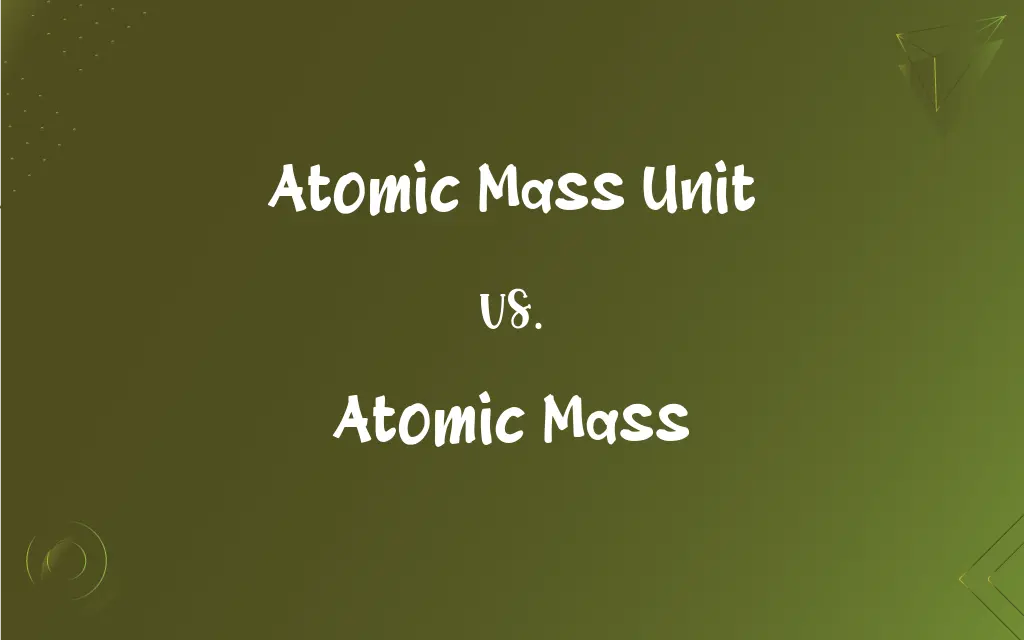Atomic Mass Unit vs. Atomic Mass: What's the Difference?
Edited by Aimie Carlson || By Janet White || Published on July 14, 2024
Atomic mass unit (amu) is a standard unit for measuring atomic mass, defined as 1/12 the mass of a carbon-12 atom. Atomic mass is the total mass of an atom, typically expressed in amu.

Key Differences
Atomic mass unit (amu) serves as a standard unit of measure for quantifying the mass of atoms and subatomic particles. It provides a scale for comparing the relative masses of different atoms. On the other hand, atomic mass represents the actual mass of an individual atom, typically expressed in amu. It accounts for the total mass of an atom's protons, neutrons, and electrons, although the electron's contribution is minimal due to its significantly lower mass.
The concept of atomic mass unit is fundamental in chemistry and physics as it offers a convenient way to express atomic and molecular masses on a scale suitable for scientific calculations. Atomic mass, in contrast, is a specific property of each element's isotopes, reflecting the variations in the number of neutrons within an atom's nucleus. This distinction highlights the role of atomic mass unit as a measurement tool, while atomic mass is an intrinsic characteristic of atoms.
Atomic mass unit is defined precisely as one twelfth the mass of an unbound neutral atom of carbon-12 at rest and in its ground state. This definition provides a basis for the atomic mass scale. Atomic mass, however, varies between different isotopes of an element due to differences in neutron count. This variability underlines the specific nature of atomic mass as opposed to the standardized atomic mass unit.
In practical applications, atomic mass unit is used to express the masses of atoms and molecules in a universally understood way, facilitating communication and calculation in scientific disciplines. Atomic mass, on the other hand, informs us about the isotopic composition of an element, which is crucial for understanding chemical behavior and properties.
The atomic mass unit is integral to the unified atomic mass scale, which is used across scientific fields to ensure consistency in the measurement of atomic and molecular masses. Atomic mass serves as a key identifier for isotopes and plays a critical role in the study of nuclear reactions and processes, reflecting the nuanced interplay between an element's isotopic composition and its physical and chemical properties.
ADVERTISEMENT
Comparison Chart
Definition
A standard unit for measuring atomic and subatomic mass.
The mass of an atom, usually measured in amu.
Basis of Measure
Defined as 1/12 the mass of a carbon-12 atom.
Sum of the masses of protons, neutrons, and electrons in an atom.
Usage
Used as a reference for comparing the masses of atoms.
Indicates the actual mass of a specific atom or isotope.
Variability
Constant and universal for all atoms and molecules.
Varies with the number of neutrons in an atom's nucleus.
Role in Science
Facilitates uniformity in the measurement of atomic masses.
Essential for understanding the isotopic composition and properties of elements.
ADVERTISEMENT
Atomic Mass Unit and Atomic Mass Definitions
Atomic Mass Unit
A unit of mass used to express atomic and molecular weights.
The hydrogen atom has a mass of approximately 1 amu.
Atomic Mass
The weighted average mass of all the isotopes of an element.
Chlorine's atomic mass is approximately 35.5 amu, reflecting its isotopic composition.
Atomic Mass Unit
1/12 the mass of a carbon-12 atom, serving as a standard for atomic mass.
The oxygen-16 isotope has an atomic mass of about 16 amu.
Atomic Mass
The total mass of an atom's protons, neutrons, and electrons.
The atomic mass of carbon-12 is exactly 12 atomic mass units.
Atomic Mass Unit
A term representing the relative mass scale for atoms and molecules.
The nitrogen molecule (N2) has a mass of 28 amu.
Atomic Mass
A property indicating the mass of an atom relative to the atomic mass unit.
Helium has an atomic mass of about 4.002602 amu.
Atomic Mass Unit
A fundamental unit in chemistry for quantifying the mass of particles.
The molecular mass of methane (CH4) is 16 amu.
Atomic Mass
The mass of an atom as compared to the defined standard of carbon-12.
The atomic mass of iron is approximately 55.845 amu.
Atomic Mass
A measure of the mass of an atom, typically expressed in atomic mass units.
Uranium-238 has an atomic mass of 238 amu.
FAQs
Why is the atomic mass unit based on carbon-12?
Carbon-12 is chosen for its stability and presence in organic compounds, providing a consistent reference point.
Can atomic mass vary between atoms of the same element?
Yes, due to isotopes, atoms of the same element can have different atomic masses.
How is atomic mass different from atomic mass unit?
Atomic mass is the total mass of an atom, while atomic mass unit is the standard unit used to express this mass.
Are atomic mass and molecular mass measured in the same units?
Yes, both are commonly measured in atomic mass units for convenience and consistency.
What role does atomic mass play in nuclear physics?
Atomic mass is crucial for understanding nuclear stability, reactions, and energy calculations.
How is atomic mass measured?
Atomic mass is measured using mass spectrometry or derived from isotopic abundances.
What is an atomic mass unit?
An atomic mass unit is a standard unit of mass that quantifies the mass of atoms and subatomic particles.
Is the electron's mass significant in calculating atomic mass?
The electron's mass is very small compared to protons and neutrons, so it's often negligible in atomic mass calculations.
How does atomic mass affect chemical reactions?
Atomic mass influences the behavior of atoms in reactions, affecting rates and outcomes based on mass-dependent properties.
What is the significance of the atomic mass unit in science?
It provides a uniform scale for measuring and comparing the masses of atoms and molecules.
How precise is the measurement of atomic mass?
Advances in mass spectrometry have made atomic mass measurements extremely precise, often to many decimal places.
What does it mean when an atom has an atomic mass of 12 amu?
It means the atom's mass is equivalent to 12 times the mass of the atomic mass unit.
Why is atomic mass important in isotopic analysis?
It helps in identifying and quantifying different isotopes of an element based on their mass differences.
How does atomic mass contribute to the periodic table?
Atomic mass is a key property listed for each element, reflecting its isotopic composition and relative mass.
Is the atomic mass unit used outside of chemistry and physics?
While most prevalent in these sciences, it's also relevant in biology and earth sciences for molecular and isotopic studies.
How is the atomic mass of an element determined?
It's calculated as a weighted average of the masses of an element's naturally occurring isotopes.
Can atomic mass change?
For a given isotope, atomic mass is constant, but it can vary across an element's isotopes.
What is the practical use of knowing an atom's atomic mass?
It's essential for calculating molecular weights, stoichiometry in chemical reactions, and understanding material properties.
How does the atomic mass unit facilitate scientific communication?
It provides a standard scale that allows scientists to easily share and compare atomic and molecular mass data.
About Author
Written by
Janet WhiteJanet White has been an esteemed writer and blogger for Difference Wiki. Holding a Master's degree in Science and Medical Journalism from the prestigious Boston University, she has consistently demonstrated her expertise and passion for her field. When she's not immersed in her work, Janet relishes her time exercising, delving into a good book, and cherishing moments with friends and family.
Edited by
Aimie CarlsonAimie Carlson, holding a master's degree in English literature, is a fervent English language enthusiast. She lends her writing talents to Difference Wiki, a prominent website that specializes in comparisons, offering readers insightful analyses that both captivate and inform.






































































